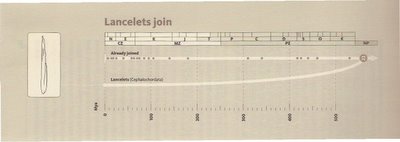When anyone comes up with talk about missing links, all I know for sure is that the person who brings up such an idea is so far off the mark as to be without merit when it comes to discussing evolution with him. The following passages are yet another place where Dawkins lays out the problems of trying to come up with moments in the gradual evolution by natural selection where one species becomes another. Once one grasps the immensity of time of the process, everything else becomes clearer. If we only understand this little much, so much more about evolution becomes clear. REMEMBER that Dawkins set his book, from which the following chart and text come, to start from the present and to move backward in time to where each of the links rejoins the main branch. That why the graph reads as it does.

[Open quote] Lancelets are live creatures, our exact contemporaries. They are modern animals who have had exactly the same time as we have in which to evolve. Another telltale phrase is 'a side branch, off the main line of evolution'. All living animals are side branches. No line of evolution is more 'main' than any other, except with the conceit of hindsight.
Modern animals like lancelets, then, should never be revered as ancestors, nor patronised as 'lower' nor, for that matter, flattered as 'higher' slightly more surprisingly—and here we come to the second main point of the Lancelet's Tale—it is probably in general safest to say the same of fossils. It is theoretically conceivable that a particular fossil really is the direct ancestor of some modern animal. But it is statistically unlikely, because the tree of evolution is not a Christmas tree or a Lombardy poplar, but a densely branched thicket or bush. The fossil you are looking at probably isn't your ancestor, but it may help you to understand the kind of intermediate stage your real ancestors went through, at least in respect of some particular bit of the body, such as the ear, or the pelvis. A fossil, therefore, has something like the same status as a modern animal. Both can be used to illuminate our guesses about some ancestral stage. Under normal circumstances, neither should be treated as though it really is ancestral. Fossils as well as living creatures are usually best treated as cousins, not ancestors.
Members of the cladistic school of taxonomists can become positively evangelical about this, proclaiming the non-specialness of fossils with the zeal of a puritan or a Spanish inquisitor. Some go right over the top. They take the sensible statement, 'It is unlikely that any particular fossil is an ancestor of any surviving species,' and interpret it to mean 'There never were any ancestors!' Obviously this book stops short of such an absurdity. At every single moment in history there must have been at least one human ancestor (contemporary with, or identical to, at least one elephant ancestor, swift ancestor, octopus ancestor, etc.), even if any particular fossil almost certainly isn't it.
The upshot is that, on our backward journey towards the past, the Concestors we have been meeting have not, in general, been particular fossils. The best we can normally hope for is to put together a list of attributes that the ancestor probably had. We have no fossil of the common ancestor we share with the chimpanzees, even though that was less than 10 million years ago. But we were able to guess, with misgivings, that the ancestor was most likely to have been, in Darwin's famous words, a hairy quadruped, because we are the only ape that walks on its hind legs and has bare skin. Fossils can help us with our inferences, but mostly in the same kind of indirect way that living animals help us.
The moral of the Lancelet's Tale is that it is vastly harder to find an ancestor than a cousin. If you want to know what your ancestors looked like 100 million years ago, or 500 million years ago, it is no use reaching down to the appropriate depth in the rocks and hoping to come up with a fossil labeled 'Ancestor', as if from some Mesozoic or Paleozoic bran tub. The most we can normally hope for is a series of fossils that, Some with respect to one part, others with respect to another part, represent the kind of thing the ancestors probably looked like. Perhaps this fossil tells us something about our ancestors' teeth, while that fossil a few million years later gives us an inkling about our ancestors' arms. Any particular fossil is almost certainly not our ancestor but, with luck, some parts of it may resemble the corresponding parts of the ancestor just as, today, the shoulder-blade of a leopard is a reasonable approximation to the shoulder-blade of a puma. [Close quote.] —Richard Dawkins, THE ANCESTOR'S TALE, pp. 365-366
No comments:
Post a Comment